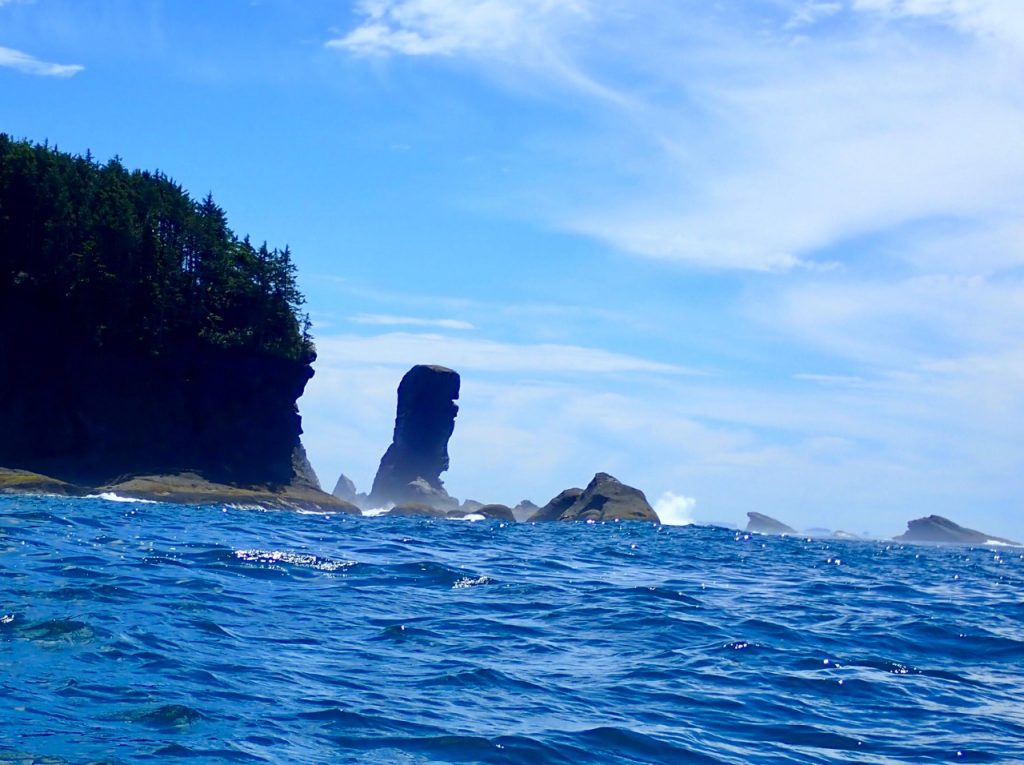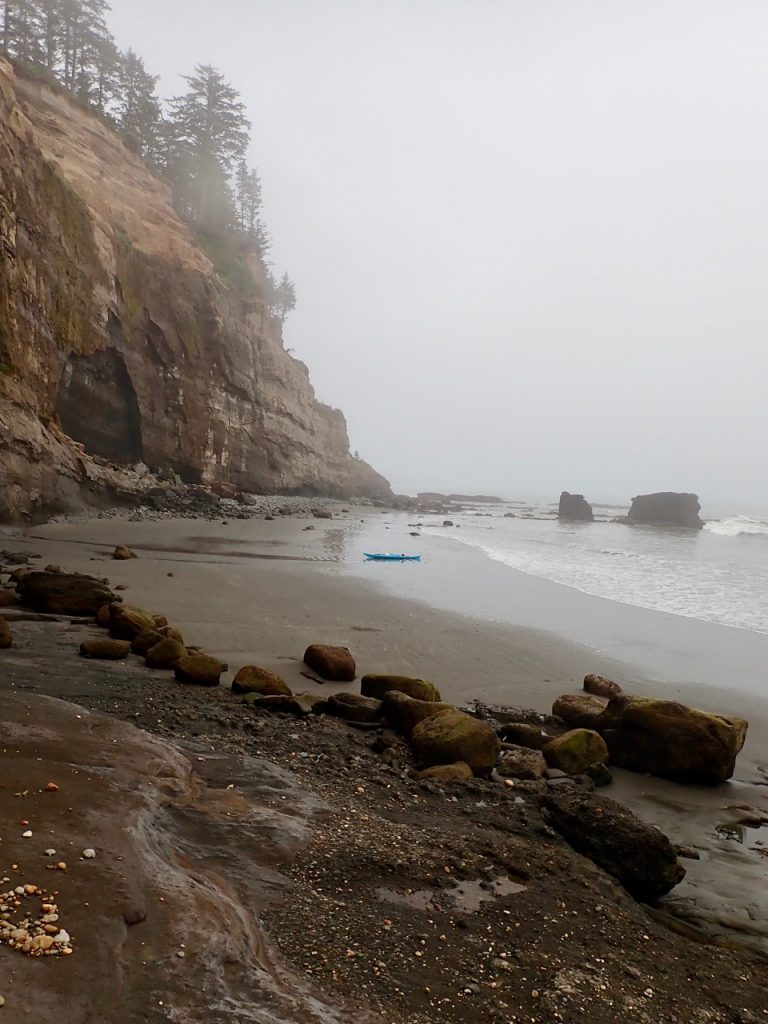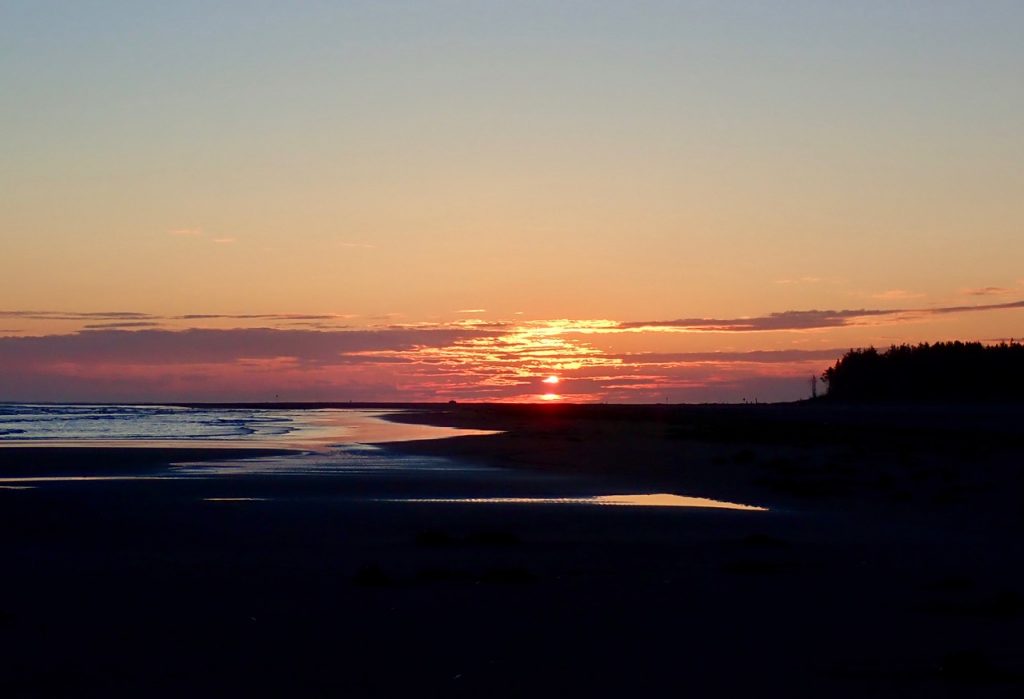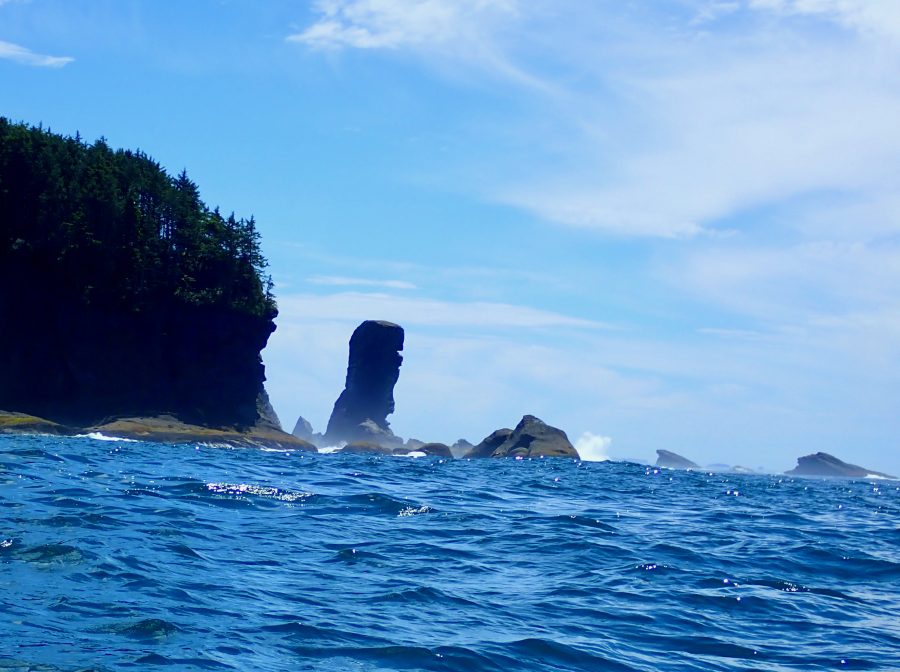Just past Point Sur, far enough past and on a beach behind a rock from the lighthouse so I could avoid the park rangers, I camped on a beach that had a different look than most of the places I’d camped on this trip. It got me thinking about the trip as a whole, instead of just in the moment or the next leg. If all went well, I was just two weeks out from the end. That was hard to believe. Almost as hard to believe as the idea, two weeks into the trip, that I was going to paddle the entirety of the West Coast of this country.
It highlights one of the pretty cool things, which is that I got to watch the slow change in the land. You’d be hard-pressed to mistake this for the Washington coast! And I got to watch the change at human-powered speed.
As I watched the land and vegetation change, I also got to see the individual pieces we usually see one at a time all strung together as a whole. Instead of this beach and that headland and this other cove, I got to watch them all come together in one coastline. I got to see beaches from the outside, the outsides of headlands that mostly just fishers get to see, the shape of the whole coast.

It’s interesting too how the coast breaks into chunks. Northern Washington was cliffs and smaller sand beaches and lots of sea stacks. Southern Washington was long sandy beaches with big bays. After crossing the Columbia River, an adventure in and of itself, northern Oregon kept the long sandy beaches and bays and added stunning headlands between them. The sea stacks got fewer and bigger. Then southern Oregon was long stretches of sand dunes interrupted by bays and rivers. There’s this little stretch of far southern Oregon that I want to go back to. It’s got lots of giant sea stacks that protect all these hidden sandy coves behind dark green water.
The people I met in the different chunks were different, too. Backpackers on those small Washington beaches among the cliffs and sea stacks of Olympic National Park. A father with two young daughters who helped me carry my boat up the beach when I landed at low tide (the dad was all over Girl Power and made sure to ask questions about my trip and to let his daughters ask questions); another family who helped me carry my boat back to the water in the morning, whose son was mostly interested in searching for crabs and whose daughter was all set to climb the “mountain” at the end of the beach. An evening walk through the campground above the beach revealed identical backpacking stoves set up but put away for the night. In the bays further south I met RV campers with big campfires and beer, and sometimes big (only slightly legal) fireworks. These beaches also hosted a lot more day users – locals walking their dogs in the mornings or evenings (I met so many great dogs!), vacationers coming to the beach for the day, couples taking romantic walks… In northern Oregon, I found people horseback riding and hang gliding along the long beaches in the north. The hidden coves behind the big sea stacks in the very southern part of the state are only accessible by hiking the Oregon Coast Trail (where overnight parking is prohibited in the parking lots, so it’s all-day users) or by boat (not motorboat – it’s too close to the rocks for them!). I met a couple holed up for the day in a cave at the top of the beach, chilling out with their didjeridu.
It starts getting more arid before California – the doug firs give way to pines and then grasses, the beaches smell different, and you start to see lizards. And you realize you really have moved south. I met a man from Spain with the same name as the Cape I was at; he’d found his soul in this landscape.
In Northern California, you get stretches of sea stacks and stretches of long sandy dumpy beaches. They’re interrupted by bays – but also lagoons that you mostly don’t see because they only have an opening to the sea when the sand spits get topped. The bays have a different shape – you get the feeling they’re more like those lagoons. In California, I started periodically getting picked up by local paddlers, many of whom I’d never met before, who would take me to their homes, feed me, give me the opportunity for laundry and a shower, and give me a place to sleep for a night or two with a roof over my head. Once, friends of one of these new-found friends picked me up and provided this hospitality. He’d surfed the California coast for 50 years and gave me good beta about the rest of the coast. The generosity of the paddling community is really remarkable!
And then comes the Lost Coast with mountains straight to the water’s edge and narrow beaches at low water that aren’t there at high water. The beaches that do stay have big dumpy surf – camping is definitely a search for protected beaches. And then you find these incredible gems once you walk to the top of the beach. I saw no one (other than hikers camped where I couldn’t land) on the Lost Coast – except at Shelter Cove. It’s a busy fishing harbor. The marina, though, is at the top of a cliff on land. When fishers head in for the day, they call ahead to the marina. For a small fee, the marina sends someone down with a tractor and a boat trailer, who loads the fisher’s boat onto the trailer and hauls it up to the marina at the top of the cliff. Really and truly. I met a couple who just wanted a place on the coast where they could drink a beer and smoke a – well, we’ll call it a cigarette. They’d found it at Shelter Cove – and they spent days there on vacation drinking beer, smoking “cigarettes”, and watching the fishing boats come in and out. I met AJ, too. He’s an old Salty who grew up fishing in the area. He told me stories of heading out in an 8-foot dinghy with just a compass and a watch to navigate with. He was curious about my trip and told me about the brothers who took surfboards from Ketchikan, Alaska to Tijuana. (I crisscrossed with their story several places, starting in La Push, Washington where I stopped at a marina to inquire about a mailbox where I could mail a letter to my husband. They had stopped there to paint patterns on the bottom of their boards to ward off shark attacks)

Fort Bragg and the Mendocino coast bring rocks and inside lines again (the chance to paddle on the land side of sea stacks or rocks instead of the ocean side. The small sea stacks – or big rocks – provide enough protection that I could have paddled close enough to the cliffs to touch them with my fingertips). As you head further south the human influence gets bigger – by the Sonoma coast, there are houses above most of the coastline and kayak fishers outside the protected coves. It was along the Sonoma Coast that I shared a beach with a Catalan couple biking from Seattle to San Francisco. We had matching tents for our adventures.
San Francisco Bay and the Golden Gate Bridge are a piece unto themselves. The juxtaposition of natural beauty and a truly beautiful piece of massive human engineering is unique. Most beautiful places are natural or human-made, not both. Just before San Francisco was the second place I paddled with anyone else. (The first place was across the Columbia River). A friend who used to live in Chicago paddled out to my campsite in Tomales Bay at night and paddled around Point Reyes with me the next day. A group of 4 people paddled with me leaving San Francisco. Unfortunately, strong south winds coupled with a flood tide that was also working against us meant that we made the decision to turn back. (The flood tide meant that as we were paddling away from the Bay, the ocean was flooding INTO the Bay – so we were paddling against the sea…) Still – company on the water and off (beers and burgers after the paddle was a great time to swap stories) was lovely.
And then you keep going, and things keep changing – and just a day out from the Bay you’re watching a notorious boomer field (a place where waves jack up over unseen rocks covered by water and can easily catch you unawares) and a long reef where Mavericks lays hidden until the right swell comes through. (Mavericks is a famous “big wave” surf spot with massive wave faces in the right conditions).
A few more days to Monterrey Bay, and then into Big Sur, where the waves against rocks felt a bit different to me – somehow more easily caught unawares. Like Mavericks, it feels like there’s a slumbering power there just under the surface. The water, when you have sunlight, is this amazing color. The cliffs come right to the water again, with very few coves that have beaches at the back. It feels similar to the Lost Coast – except there are expensive houses atop pretty much every cliff. (You don’t see them in the fog though…) The granite here made it seem like paddling next to the Rocky Mountains. I had company a couple different days after San Francisco, including crossing Monterrey Bay. In Big Sur, though, I didn’t see anyone. This is where I stopped at the place just south of Point Sur that looked so different from other places I’d camped. The next night saw one of my favorite campsites, with a freshwater lagoon and a big beach and a curious coyote in the morning. The coyote, and bugling elk at Tomales Bay, was one of the few land mammals I saw on the trip. Marine mammals, though, were amazing – whales surfacing and feeding and breaching, dolphins jumping within feet of my boat, sea lions chortling from the rocks, popping up behind me, or taking a good look at me from the front before careening away from me. And birds! I especially like pelicans. Pelicans and common murres. (They look like loons on the water – and like penguins when they fly or stand. Isn’t that just the coolest thing?) I was fascinated by egrets and herons in Big Sur – they stand on the kelp beds and fish!

And then you come out and head to Morro Bay, where it’s not far to Point Conception and Southern California. One of the more perplexing encounters I had was on the water just offshore of a nuclear power plant south of Morro Bay. I wasn’t the full mile offshore I was supposed to be – and a surfer-looking dude with wild blond hair, a metallic green wetsuit, and a lifejacket (?? OK, so that’s not so surfer-dude-looking…) on a jet ski came out to talk with me.
“You OK?”
Yep, I was good.
“Awesome, man. Just checking in.”
And he meandered off on his jet ski – towards the nuclear power plant.
The jury’s out about whether he was a low key security guard, or a dude out enjoying the water…
Anyway, I’d been told everything changes at Point Conception, which was just a couple days away now – the swell, the water temperature and color, the level of risk. And it’s Southern California – I was almost done camping. (Because how do you camp through LA and San Diego? I’d been told it was possible – but I didn’t want to try to search for hidden camping spots in the midst of huge population centers). Things did change at Point Conception – the swell was minimal, the wind was minimal (despite several days of headwinds!), the water was decidedly warmer, the weather was mostly sunny and warm, and after a (marginally legal) final beach campsite with dolphins playing in the water next to me as I landed and bioluminescence in the waves after dark, I was done camping – nights were among people in civilization. The smell of the beaches changed – mostly you can smell the pollution. But sometimes there was this surprising sweet smell that wafted from the beaches. It smelled a bit like freshwater. As in not saltwater. In the desert, a few beaches had this lush meadow smell coming off them. (I didn’t understand it).
And then there was my landing, where the sounds stand out. There’d been sounds along the way. The grumbling and chatting of common murre rookeries; the belching and snorting and yelling and mumbling of sea lions; the pop of dolphins, sea lions, or whales surfacing; the Harley Davidson sound of elephant seals on a beach too far away to be as loud as they were; the sound of an actual engine of a boat off on the horizon or fishers talking through the fog or a shipping container turning or accelerating; the myriad sounds that water makes, whether it’s the fold of a wind wave behind me, the smack or boom of a wave that seems way too small to make that sound against the cliff it just hit, the slow, inexorable rumbling and crashing of a wave coming over and around a rock; the chortling and chatting of sea lions and birds on rocks far enough away that they sound like humans singing, reminding me of Odysseus and the singing of the sirens. In Southern California, the sound of music pulsed from the beach-side bars and I started hearing traffic (I also used a traffic sign on the freeway once as an aid to navigation).
The sounds at my landing were unique. Family and friends were there to meet me. They’d told everyone on the beach what I was doing. So when I got close, the whole beach erupted in cheering and applause. There was whistling, a stranger’s assurance of a cold beer waiting for me on shore (it was actually champagne!).
And just like that, my trip was over. I’d paddled 1508 miles through a stunningly, exquisitely beautiful changing landscape. My journey through that external landscape changed my internal landscape. I don’t know the contours of this landscape yet. I hope what I will find includes a fierceness borne of the wildness of water against rock. A serenity that mirrors the calm protected waters in those inside lines behind the solid, immovable sea stacks. A joy that mimics the none-may-care, over-the-top abandon of the ridiculous and delightful sea lions chortling and belching and calling on the rocks as they go about our daily lives. I hope, at least periodically, that I can enjoy the everyday, mundane, breathtaking beauty in which we live and move and breathe – and chortle and belch – with the same reckless, absurd abandon of the sea lions.

